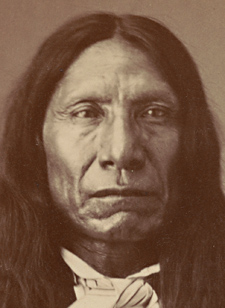
Vanished Worlds, Enduring People
European Encroachment, Native Resistance
As European colonists and their successors moved relentlessly westward, they forced Native Americans to relinquish their traditional lands, and with it, their sovereignty. The struggle for land is a major theme in Native American history.
Diplomatic accords, brokered to avoid impending crisis rather than to establish lasting agreements, invariably collapsed in the face of settlers’ demands for more space. Indians responded to broken treaties with a combination of retreat, strategic alliances with European rivals, and armed resistance. The American colonists’ victory in the War of Independence presented Native Americans with a single expansionist power, intent on continental domination.
All forms of native resistance proved ineffective. The Cherokees gained no relief from their successful appeals to the Supreme Court. And fierce armed resistance from Plains tribes, even their resounding victory at the Little Bighorn, would not prevent settlers and miners from entering their territory. The tragic confrontation at Wounded Knee in 1890 marked the end of large-scale armed resistance by Native Americans.